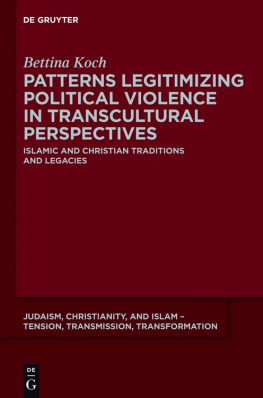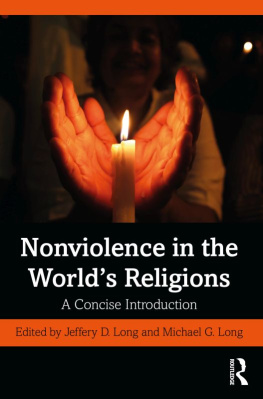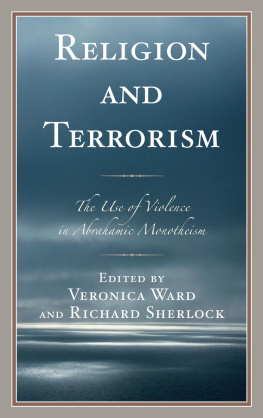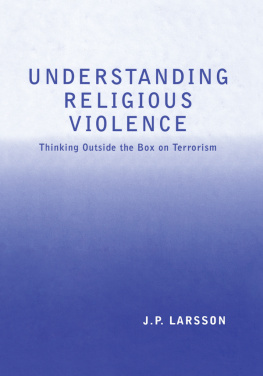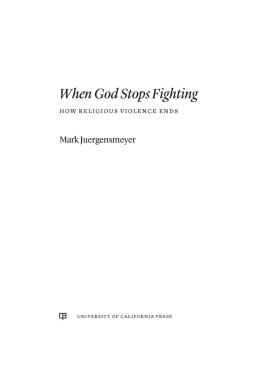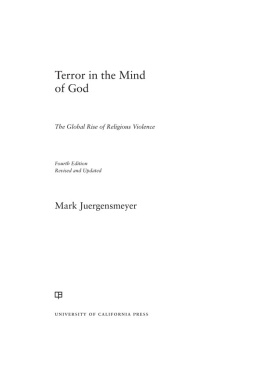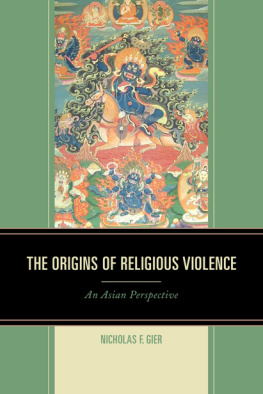Princeton Readings in Religion and Violence
Princeton Readings in
Religion and Violence
Edited and with introductions by
Mark Juergensmeyer and Margo Kitts

Copyright 2011 by Princeton University Press
Published by Princeton University Press, 41 William Street, Princeton, New Jersey 08540 In the United Kingdom: Princeton University Press, 6 Oxford Street, Woodstock, Oxfordshire OX20 1TW
press.princeton.edu
All Rights Reserved
Library of Congress Cataloging-in-Publication Data
Princeton readings in religion and violence / edited and with introductions by Mark Juergensmeyer and Margo Kitts.
p. cm.
Includes bibliographical references and index.
ISBN 978-0-691-12913-6 (hardcover : alk. paper) ISBN 978-0-691-12914-3 (pbk. : alk. paper) 1. ViolenceReligious aspects. I. Juergensmeyer, Mark. II. Kitts, Margo, no date. III. Title.
BL65.V55P75 2011
201'.76332dc22 2011013613
British Library Cataloging-in-Publication Data is available
This book has been composed in Sabon
Printed on acid-free paper.
Printed in the United States of America
1 3 5 7 9 10 8 6 4 2
Contents
Whether It Is Always Sinful to Wage War?
Summa Theologica
Acknowledgments
A SPECIAL WORD OF APPRECIATION goes to Fred Appel of Princeton University Press for his persistence and unfailing belief in the value of this project. Assistance in securing publishing permissions for the selections was provided by Jack Ucciferri, Jeff MacMillan, and Hamed Faquiryan, and useful comments on the manuscript were provided by Michael Jerryson. Margo Kitts would like to thank her son, Giordan, for his good-natured support; and Mark Juergensmeyer appreciates the patience of his spouse, Sucheng Chan.
In acknowledging their appreciation for the contributions of each other in producing this book, the editors also want to explain how this book came about and what each of them did in producing it. Years ago, Juergensmeyer was one of Kittss graduate advisers when she did her doctoral work at Berkeley. When Juergensmeyer was approached about doing a book of readings in religion and violence, he realized that the volume would be greatly enhanced by a coeditor who knew well the literary and anthropological material on the subject and he turned to Kitts. Happily, she agreed to collaborate on the project. The book was conceptualized through vast amounts of email between Honolulu and Santa Barbara, and at a crucial meeting in a coffeehouse in Berkeley. The introductory essay of the volume was written together. Juergensmeyer wrote a draft of the introduction to section I and wrote drafts of the paragraphs introducing each of the selections in this section; Kitts drafted the introduction to section II and its selections; and Juergensmeyer drafted the concluding comments. Then they edited and rewrote each others essays and argued about the whole thing. Surprisingly, they are still friends.
Princeton Readings in Religion and Violence
Introduction
WHY IS RELIGION VIOLENT AND VIOLENCE RELIGIOUS?
VIOLENCE IN THE NAME OF RELIGION, plentiful enough in our time, is an enduring feature of religious life. Rituals of sacrifice and martyrdom and legendary tales of great battles abound within every religious tradition. In most cases the violent images are symbolic, but the reality of religion is clouded with actual events of violenceinquisitions and internal attacks, sacrifices and martyrdoms, wars and conquests. Virtually every religious tradition has left a trail of blood.
Some would argue that the violent images in religion are greatly misunderstood. Religion itself is not violent, these defenders of religion claim, but a voice of peace. Rather, the misuse of religion leads to violencestealthy activists legitimizing their deeds with religious justificationsand that sullies the purity of religions reputation.
We agree, in part, for indeed most religious teachings are about peace. They not only preach tolerance and understanding of those who are different but advocate forgiveness and mercy in the face of opposition. The idea of killing is abhorrent to all religious traditions, and even the attempts to coerce and bully are regarded as anathema. We wish that this volume were large enough to include the peaceful sides of religion and to counteract all of the violent passages.
Yet we feel that there is value in having a volume that focuses on the destructive side. After all, these brutal passages exist, and despite the overwhelming peacefulness of religious traditions, the fact remains that they are also filled with the symbols and language of violence. Why is this the case? It may well be, as some will claim, that these images help to alleviate real violence by symbolically displacing violent urges. It also may be true that religious violence is the rare exception rather than the rule. Yet these are precisely what need to be explainedhow religious language can embrace violent images and acts, and why, and on what occasions, and how it is possible that symbolic violence can turn to real acts of bloodshed.
The link between religion and violence extends back into the early history of religious traditions. The sword of Islam and the cross of Christianityan execution deviceare only the most obvious indications of ancient associations with bloody images in religious culture. Tales of violence are frequent in the most ancient Western texts, from the Bible through the Assyrian and Hittite royal annals to the earliest Sumerian and Akkadian poetic celebrations of such deities as Ishtar, Ninurta, and Nergal. The violent images in Asian religious traditions are equally ancient. The auspicious acts of destruction undertaken by Vedic gods such as Indra and Rudra are conspicuous in early Indian poetry and epic, and the martial arts traditions associated with Taoism and Buddhism reflect principles based in 2,500-year-old textsand some would say in the cosmos itself.
Virtually all cultural traditions have contained sacrificial acts and martial metaphors. Some would argue that the rise of religion is intimately related to the origins of sacrifice. But images of warfare are equally ubiquitous and similarly ancient. The Muslim notion of jihad is the most notable example, but even in Buddhist legends great wars are to be found. In Sri Lankan culture, for instance, virtually canonical status is accorded to the legendary history recorded in the Pali Chronicles, the Dipavamsa and the Mahavamsa, that relate the triumphs of battles waged by Buddhist kings. In India, warfare has contributed to the grandeur of the great epics, the Ramayana and the Mahabharata, which are tales of seemingly unending conflict and military intrigue. Arguably, more than the Vedic rituals, these martial epics defined subsequent Hindu culture. In Sikhism, the Dal Khalsa (army of the faithful) is the term for the Sikh community, denoting a disciplined religious organization. Great passages of the Hebrew Bible are devoted to the military exploits of great kings, their contests reported in gory detail. Though the New Testament did not take up the battle cry, the later history of the church did, supplying Christianity with a bloody record of crusades and religious wars. Protestant Christianity is an example. Although the reformed tradition is strongly pacifist, martial images abound in the rhetoric and symbolism of the faith. Protestant preachers everywhere have encouraged their flocks to wage war against the forces of evil, and their homilies are followed with hymns about Christian soldiers, fighting the good fight, and struggling manfully onward. Given both the antiquity and the persistence of such images, it seems reasonable to conclude that violence is in some way intrinsic to religion.
Next page

